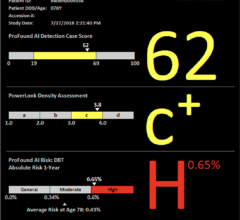
May 9, 2012 — For decades, non-imaging gamma probes have been used to guide surgeons to critical lymph nodes in cancer patients. More recently, a procedure has been developed to guide tumor surgery using the same probe; however the non-imaging probes used in these procedures cannot provide accurate depth information. According to results presented by two medical institutions at the Society of Surgical Oncology 2012 Annual Cancer Symposium on March 21, the SurgicEye declipseSPECT (single photon emission computed tomography), an intra-operative handheld 3-D image-viewing device cleared by the U.S. Food and Drug Administration (FDA), may improve the accuracy of these procedures by providing 3-D images of the tumor and lymph nodes.
Leading surgeons from the Netherlands Cancer Institute in Amsterdam presented on the use of the declipseSPECT in the radio-guided resection of non-palpable breast cancer. Their results showed that declipseSPECT could support radio-guided surgery by determining the precise 3-D localization of the marked cancer and lymph nodes in the operating room. In addition, the system allowed them to determine the depth of each structure and to image the lumpectomy specimen to verify margins; all margins were verified to be negative by pathology.
“The innovative 3-D declipseSPECT technology may make the sentinel node biopsy easier and more reliable. New technologies like 3-D declipseSPECT will also open up lymphatic mapping to additional cancer types, cancer types in locations with a more intricate anatomy and cancer types with more complex lymph drainage," said lead author, Omgo E. Nieweg, the Netherlands Cancer Institute.
The team of surgeons from the general surgery department of the University Hospital of the Technische Universitat Munchen, Munich, Germany, presented on the use of the declipseSPECT in locating sentinel nodes of melanoma patients. The system enabled the physicians to intra-operatively image all of the nodes seen in pre-operative imaging. In addition, by using the device for post-excision imaging in the operating room, the team was able to confirm and document complete resection of the nodes.
The declipseSPECT device is provided in the United States exclusively by Dilon Diagnostics. “The declipseSPECT system is a natural fit for our product portfolio since it extends gamma imaging capabilities in the operating room. We are excited and encouraged by these results and our company continues to lead the molecular imaging market through innovation and partnerships like the one we share with SurgicEye,” said Dilon CEO Robert Moussa.
For more information: www.molecularbreastimaging.com, www.surgiceye.com


 July 30, 2024
July 30, 2024 








